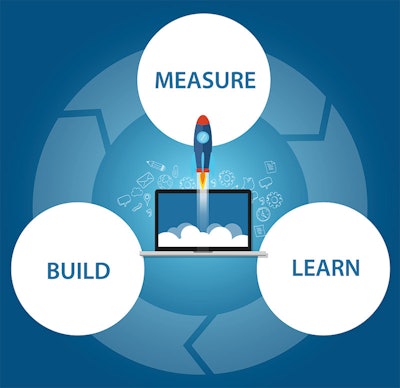
 Angela Hill
Angela HillToday’s manufacturing businesses are no stranger to the agile development mindset. When mass-producing products, manufacturers uniquely appreciate the importance of refining iterations prior to creating the final mold. Similarly, when employing an agile mindset to marketing, business owners can ensure that the majority of glitches have been worked out prior to setting their final marketing strategy. The goal here is to avoid spending too much time and money on poor performing marketing tactics. Iterating in real-time ensures that minimal marketing budget is wasted because you’re constantly analyzing and strategically redirecting time, talent and money to best-performing tactics.
Just as the 80/20 rule can be a good strategy for your sales focus, similarly smart marketers can employ the 80/20 rule to their agile marketing strategy. Rather than chasing perfection and waiting for every single message, image and tactic to perform to it’s highest potential, agile marketers can build in flexibility to enable testing 80 percent of your marketing tactics while maintaining a stable non-flexing strategy for 20 percent of your marketing mix. Creating space and permission for imperfection enables your marketing to avoid being measured by “right now” short-term results and instead focus on “ideal” long-term outcomes. In doing so, you can minimize marketing risk by decreasing your budget when testing and then later increase your marketing budget only after validating and verifying best-performing tactics.

Concurrent engineering methodology is a vital component of the agile marketing mindset. Rather than sequential engineering where you think and then make a choice, agile marketing encourages you to think and make choices in real-time. The secret to agile marketing’s success is the commitment to strategically and methodically experimenting, measuring, and evolving your marketing on a weekly basis. Only by planning to modify and iterate on a regular and consistent schedule can you control the uncomfortable unpredictability of agile marketing. Planning for the end goal at the start guarantees that your marketing team will be focused on the ideal outcome of MQLs (Marketing Qualified Leads) that convert and turn into consistent, profitable revenue.
It is important to get buy-in to the agile marketing framework from every level — from the C-suite to key executives and from sales to marketing. If the CFO doesn’t understand that marketing needs to spend a small amount of marketing budget on a lot of different marketing strategies prior to committing to best-performing marketing tactics, then marketing leaders might have their budget taken away right before they’re about to hit their stride and instead have it redirected to the sales team. If the VP of Sales and the sales team don’t share with marketing which leads performed best and converted fastest, then marketing is flying blind serving up leads but focusing on volume instead of quality. And, if marketing is not properly tracking the source of leads as they get ported into the sales CRM system, then how can they explain to the C-suite why they need more budget for a particular marketing tactic that is statistically proven to deliver higher sales ticket customer leads.
Death by papercuts is a horrible way to kill your marketing budget. In a traditional waterfall marketing approach, marketers can get paralyzed by paperwork and wanting to perfect their marketing plan prior to acting on their proposed marketing strategies. Marketing leaders can get sidetracked wanting to build out every aspect of their marketing plan, editorial calendar and marketing budget. The problem with wanting to fully define every aspect of your marketing is that by the time you have documented all of your brilliant marketing ideas, your competition may have moved the mark by refocusing your target audience’s focus on a different key differentiator or functionality.

In today’s evolving marketing environment, marketing technology is changing on a weekly basis. If you wait to start employing marketing tactics till your plan is defined, marketing platforms that worked last year or even last month may no longer be effective. Worst yet, those same marketing platforms may no longer integrate with your marketing automation or sales CRM systems for proper tracking. In an agile marketing environment, marketing technology can be quickly tested and refined in real-time to determine which tactics will perform best. Agile marketing mentality can minimize risk and improve results by testing software quickly and allocating budget to best performers in real-time.
The final and most critical component for manufacturers looking to employ an agile marketing methodology is trust. Being comfortable with not knowing and not controlling outcomes is scary, but wasting budget by chasing the wrong leads in a traditional waterfall marketing approach is a lot scarier. Guarantee that your manufacturing organization adapts faster than your competition by employing agile marketing strategies to keep up with changing industry trends and marketing technology. Embrace the unpredictability of your agile marketing plan by managing to ideal outcomes rather than quantity of leads. In the end, you’ll focus your energy on better, smarter marketing results and improving sales cycles leading to more profitable, predictable revenue.
Angela Hill is CEO of Incitrio Marketing.




















